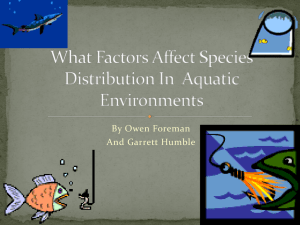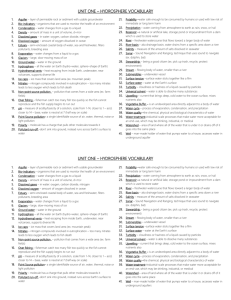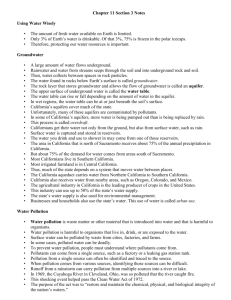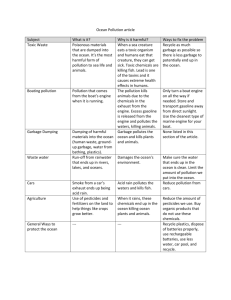WATER QUALITY QUIZ
advertisement
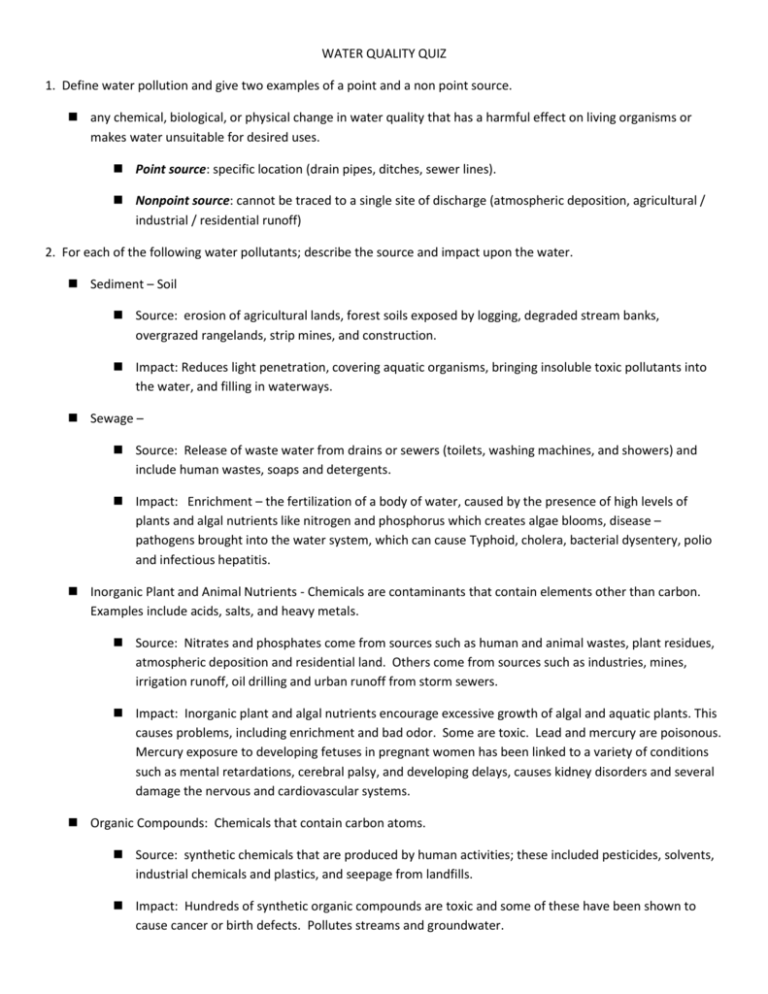
WATER QUALITY QUIZ 1. Define water pollution and give two examples of a point and a non point source. any chemical, biological, or physical change in water quality that has a harmful effect on living organisms or makes water unsuitable for desired uses. Point source: specific location (drain pipes, ditches, sewer lines). Nonpoint source: cannot be traced to a single site of discharge (atmospheric deposition, agricultural / industrial / residential runoff) 2. For each of the following water pollutants; describe the source and impact upon the water. Sediment – Soil Source: erosion of agricultural lands, forest soils exposed by logging, degraded stream banks, overgrazed rangelands, strip mines, and construction. Impact: Reduces light penetration, covering aquatic organisms, bringing insoluble toxic pollutants into the water, and filling in waterways. Sewage – Source: Release of waste water from drains or sewers (toilets, washing machines, and showers) and include human wastes, soaps and detergents. Impact: Enrichment – the fertilization of a body of water, caused by the presence of high levels of plants and algal nutrients like nitrogen and phosphorus which creates algae blooms, disease – pathogens brought into the water system, which can cause Typhoid, cholera, bacterial dysentery, polio and infectious hepatitis. Inorganic Plant and Animal Nutrients - Chemicals are contaminants that contain elements other than carbon. Examples include acids, salts, and heavy metals. Source: Nitrates and phosphates come from sources such as human and animal wastes, plant residues, atmospheric deposition and residential land. Others come from sources such as industries, mines, irrigation runoff, oil drilling and urban runoff from storm sewers. Impact: Inorganic plant and algal nutrients encourage excessive growth of algal and aquatic plants. This causes problems, including enrichment and bad odor. Some are toxic. Lead and mercury are poisonous. Mercury exposure to developing fetuses in pregnant women has been linked to a variety of conditions such as mental retardations, cerebral palsy, and developing delays, causes kidney disorders and several damage the nervous and cardiovascular systems. Organic Compounds: Chemicals that contain carbon atoms. Source: synthetic chemicals that are produced by human activities; these included pesticides, solvents, industrial chemicals and plastics, and seepage from landfills. Impact: Hundreds of synthetic organic compounds are toxic and some of these have been shown to cause cancer or birth defects. Pollutes streams and groundwater. Radioactive Compounds: Contains atoms of unstable isotopes that spontaneously emit radiation Sources: Radioactive substances get into water from several sources like the mining and processing of radioactive minerals such as uranium and thorium, the nuclear weapons industry, and medical and scientific research facilities also use them. Impact: Mutations, birth defects, mental retardation, genetic disease, leukemia, cancer (breast, bone, thyroid, skin, lung), burns, cataracts, male sterility Thermal Pollution: Sources: When heated water produced during certain industrial processes is released into waterways. Impact: Decomposition of wastes occurs faster, depleting the water of oxygen; this affects aquatic life. Typically affects animals, not humans. 3. Name the three largest sources of water pollution in order of greatest to smallest. Agricultural, municipal, industrial 4. What is the dissolved oxygen level that is considered gravely polluted and only a few organisms can survive at this level? 4 ppm 5. Why must you state the temperature whenever reporting dissolved oxygen? Gas solubility is dependent upon temperature – more gas dissolves at colder temps. 6. Describe why lake pollution is usually more severe and harder to rectify than stream pollution. Dilution of pollutants in lakes is less effective than in most streams because most lake water is not mixed well and has little flow 7. What percentage of earth is covered by salt water? 71% 8. Describe two ways the ocean impacts our planet. Distributes solar heat. Gigantic reservoir for carbon dioxide; therefore they help regulate the temp. of the troposphere 9. Give the names of the two major zones of the ocean. Coastal and Open sea 10. Define an estuary and describe a service it provides to the environment. A coastal body of water, partly surrounded by land, with access to the open ocean and a large supply of fresh water from a river Benefit – most fertile ecosystem in the world. 11. Match the Coastal region with its description. a. The deepest part of the beach; farther into the water, before the breaker bar that forms waves b. Shallow zone where the waves begin to form c. Doesn't flood often, except during hurricanes, (1) Backbeach (d) (2) Fore-Island Dune © (3) Lowershore Face (a) (4) Forebeach (e) etc. Constantly changing due to the wind (5) Uppershore Face (b) d. Only under water during high tide e. Contains the swash zone – place where the waves crash. 12. Name and describe the 4 zones of the open ocean region. Pelagic: The open ocean environment; divided into neritic (open ocean from the shoreline to a depth of 200m) and oceanic provinces (depths > 200m). Euphotic: Lots of light. From 0 - 200 meters. Photosynthesis takes place here. Bathyl: The dimly lit part of ocean. From 200 - 1500 meters. Abyssal: Completely dark. Extends to a depth of 4000 to 6000 meters (2.5 to 3.7 miles). Water here is very cold & has little dissolved oxygen. 13. What is the name of the most diverse marine ecosystem? Coral reef 14. Describe the three types of sewage treatment. Primary a physical process that uses screens and a grit tank to remove large floating objects and allows settling Secondary a biological process in which aerobic bacteria remove as much as 90% of dissolved and biodegradable, oxygen demanding organic wastes. Tertiary - chemical and physical processes to remove specific pollutants left (especially nitrates and phosphates 15. Describe the purpose of each of the following laws: Safe Drinking Water Act - determine the maximum contaminant level, the max permissible amount of any pollutant that might adversely affect human health. Clean Water Act - sets standards for allowed levels of key water pollutants and requires polluters to get permits. Two basic goals: To eliminate the discharge of pollutants in U.S. waterways and to attain water quality levels that make these waterways safe to fish and swim in. Water Quality Act controls toxic pollutant discharges, controls non-point sources of pollution, authorized $18 billion for wastewater treatment, addresses problems such as coastal estuaries, the Great Lakes, and the Chesapeake Bay 16. What is the name of the agency that monitors the world’s water quality? WHO (World Health Organization) 17. From the list below, write the name of the major parameters water quality with their description. Phosphate(f) hardness (L) nitrate (a) turbidity (k) Iron(e) Giardia (h) Sulfate (d) pH (j) chloride (I) CO2(b) DO(c) Coliform(g) A. Contaminates shallow groundwater (100 feet or less) and usually comes from fertilizers. It’s a concern in rural areas where 80-90% of the residents use shallow groundwater for drinking. This harms humans because it reduces the blood’s ability to transport oxygen. B. Enters aquatic systems from the atmosphere and from respiration by animals. The concentration varies at different depths because of light/photosynthesis. C. Measured at a particular temperature and pressure is dependent upon critical for marine animals. D. Problem because too much can kill fish. Gets in water from industrial processes and mining. E. Causes problems because it separates out of the water and forms particulates (sediment), it tastes bad if it gets in our water, and can coat fish’s gills. Groundwater problems in wells, from natural minerals in rocks. F. Plant nutrients that cause algae blooms. It comes from detergents, human wastes and fertilizers. G. General group of bacteria from animal wastes. It uses up available oxygen. Also causes e-coli disease. H. Organism (protozoa) that can cause diarrhea if you drink unchlorinated water. It is a natural organism that lives in the guts of animals. I. Part of salts, but too many can cause too much salt in the water. Too much is bad; a little is okay. It is naturally found in water, but can come from pollution. J. A level too high/too low can be bad; fish like 6.5-9.5; can kill fish. K. Cloudiness/muddiness; blocks the light; coats fish gills. L. Calcium and magnesium dissolved in the water. A little is good (50-400 ppm for fish is good), but very low or high is a problem. Low is more of a problem. Affects fish eggs, poor bone development.
